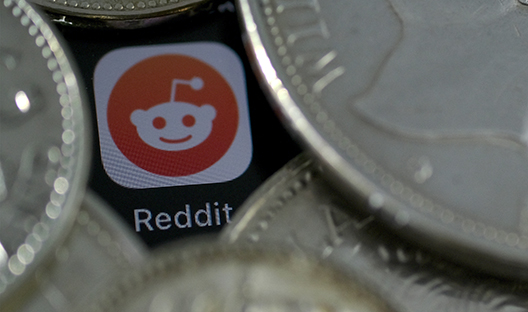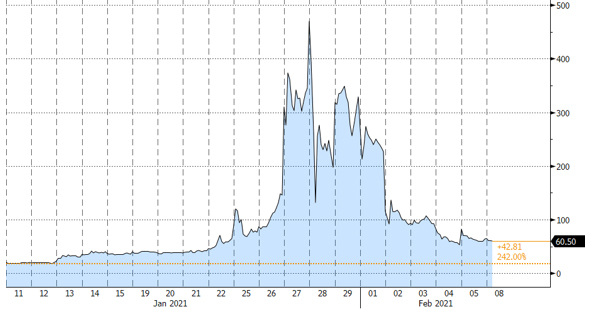Get Roger Lee’s Equities delivered to your inbox

Surges of interest in the stock market from retail investors are nothing new. Paul Killik, the founder of the eponymous Killik & Co retail brokerage, once told me that during the late 1980’s UK privatisation boom, his “share shop” concession in Debenhams, Oxford Street was the most profitable retail square footage across the whole store.
Recently, a combination of time or boredom, cash from stimulus cheques or even limited sport on TV has driven a surge in US retail investing. Technology has enabled this surge in demand with the growth of “one-click” online trading platforms offering zero commission equity trading. The best known of these new platforms is undoubtedly Robinhood. With all the zeal of typical tech disrupters, Robinhood is ‘’on a mission to democratize finance for all.’’
Technology is also enabling the information flow which drives trades. The rise of trading chat rooms on social media platforms like Reddit now offers anyone the opportunity to share in ‘’market chat’’, once reserved for a privileged few on the floor of a stock exchange.
What is margin trading and short-selling?
But I doubt even the visionary Paul Killik could see how this merry band of retail investors on Robinhood, who shared information on a Reddit chatroom “wallstreetbets”, could take on the might of the US hedge fund industry. I also don’t think anyone could have foreseen the dramatic movements in a few obscure US stocks caused financial markets around the world to correct so sharply over three trading days at the end of January 2021. The answer is nothing new, but a combination of old fashioned margin trading and short-selling.
Margin trading is buying and selling stock using borrowed funds with a relatively small amount of deposit or collateral. Similar to how a deposit is used to finance a mortgage. This deposit or collateral is known as margin.
A cursory glance at IG Index’s website shows you can “buy” or “sell” the FTSE 100 Index with a margin requirement of 5%. So subject to all their T&C’s, for a margin payment of say £50,000, IG Index may be prepared to offer an investor £1m FTSE 100 equity exposure. If you have bought the FTSE 100 in this way and it happens to go down more than 5% then you will be asked to pay more collateral or margin to meet any shortfall. Conversely, if you have sold the FTSE through IG using margin and it goes up over 5% again you will be expected to increase your deposit or margin to meet any shortfall as if the position was to be closed on any particular day. These increases in margin to meet any potential losses are called margin calls.
There is also nothing new about short-selling. The practice of short-selling a share was first recorded on The Amsterdam Stock Exchange back in the early 1600s.
Short-selling is selling stock you have borrowed and don’t actually own. To go “short” an investor ‘’borrows’’ shares on payment of a small amount of “margin” on the condition that he must return or “deliver” those shares at some future point. He then sells those shares in the market and at that point, he is in deficit to his counterparty or as we describe it, ‘’short’’. Furthermore once an investor is ‘’short’’ there is no absolute limit to how high a share price can rise, so the losses incurred can be unlimited unlike when you own shares or are ‘’long’’ where the price can only fall to zero.
There is also nothing new about short-selling. The practice of short-selling a share was first recorded on The Amsterdam Stock Exchange back in the early 1600s. More recently, in the 1940’s the first investment fund was launched in the US that short sold stocks, to reduce or hedge out the market risk to exploit share price anomalies, without worrying about broader market moves. So the “hedge fund” was born.
However, it’s the requirement of delivering the physical shares back to the lender that makes short-selling unique. It was the inability to deliver these borrowed shares and the subsequent unlimited nature of the potential losses that quickly caused the financial strain we saw at the end of January.
So, what happened with GameStop?
GameStop is a traditional high street video game retailer. It is perceived that buying video games in a physical store has limited prospects as the future is downloading games directly. For this reason, GameStop became a popular short.
Through quirks of financial engineering at one point, 138% of its market cap was sold short. More stock was borrowed than physically existed. This observation did not go unnoticed on the Reddit chat room “wallstreetbets” who shrewdly surmised if a group of retail investors started buying the stock, then at some point, the hedge fund shorts would have to ”close their shorts” and “deliver” the physical stock they had borrowed back to their counterparties.
Given there was more stock shorted than physically existed at some point, arithmetically, demand would significantly exceed supply, the short sellers would be “squeezed” and so the price of GameStop would - as predicted in the chat room - “go to the moon”. That is exactly what happened as can be seen in the chart below. GameStop went from around $6 at the beginning of September 2020 to $20 on 11 January 2021, to $76 on 26 January, $147 on 27 January. Before trading, at an intra-day peak, at $483 on 28 January. This squeezing of the short sellers and subsequent price action is known as a “short squeeze”.
GameStop one month share price chart

Source: Bloomberg
As the short squeeze starts, other strains become apparent. As GameStop and the other “most shorted” stocks began to rise there would have been significant margin calls that would need to be funded, probably from selling other assets. As losses start to rise, hedge funds would have to decide whether to close or cover their positions by selling other stock or assets to buy GameStop. This is known as ‘’short-covering’’. Of course, given the limited availability of GameStop stock, all this short covering only exacerbates the short squeeze. If investors can’t meet the margin requirements, the liability rests with the broker to deliver the stock back to the lenders. The brokers themselves face higher margin calls and so stress starts to build more broadly across the financial system.
Why were global financial markets rocked?
As stress builds, inevitably fear builds. Counterparties demand higher collateral across the market. Investors may also be unwilling or unable to make further margin payments, even if not directly involved in the short squeeze. They start selling stock to close their short positions.
There is also a cost to borrow stock, much like an interest rate on any loan. The cost to borrow may rise significantly across the market from 1-2% to 10% or even higher as stock lenders are reluctant to loan additional stock. With rising borrow costs, short-sellers may find short trades uneconomic and close their short positions again funding any short-covering by selling other stock.
As this selling pressure builds, fear of instability may encourage investors across the world to sell equities and invest in safer assets like government bonds or gold.
We saw all of the above over the last three trading days of January where the S&P fell 4%, the MSCI World Index fell 3.5% gold rallied $40 an ounce and US Treasury yields fell 10 bp as investors sought safety from any potential collateral damage from the short squeeze.
As this selling pressure builds, fear of instability may encourage investors across the world to sell equities and invest in safer assets like government bonds or gold.
The hedge fund at the centre of the short squeeze did apparently close their positions in GameStop. According to the Financial Times (6 February), the hedge fund needed a cash injection of $2.75 billion and lost 53% of the $13bn it was managing at the start of January. The Robinhood platform that the retail investors were using needed to issue $3.4bn of convertible debt to fund their own margin requirements. At the time of writing, GameStop is trading at $53, down 88% from its intra-day peak.
Could this happen again?
So why is this instability allowed to happen? Governments have tried to regulate short-selling ever since a banking crisis caused by speculative short selling of The East India Company in the 18th century. Short-selling supposedly exacerbated the 1929 crash and more recently caused the collapse of Barings and famously the short-selling of sterling “broke the Bank of England” forcing the UK to leave the European Exchange Rate Mechanism. The short positions of LTCM, one of the largest hedge funds at the time, caused its collapse and Asian regulators still heavily regulate short-selling since the 1998 Asian Crisis.
However, short-selling remains a fundamental instrument in an investor's toolkit, despite all the risks and regulations. Philosophically, I believe short-selling is as legitimate as buying stock, it is essential for hedging risk and as acceptable as borrowing and lending between two willing parties - as long as both understand the risks and adequate collateral requirements are provided to protect the financial system. The stock lent to short sellers is often borrowed from large inactive investment funds like life insurance funds or index-tracking funds, so short-selling provides additional valuable liquidity, actively trading stock that would otherwise be passive and inert. So short selling leads to increased liquidity in markets and more liquid markets are perhaps paradoxically more orderly. Short-selling is also vital in providing “price discovery” and efficiently finding the right price for any asset is also essential for a well-functioning market.
This short squeeze also highlights another feature of stock markets that I find so fascinating - the tangled web of interconnectivity between financial markets. The unintended cause and effect of the short-selling of an obscure video game retailer in the US can have implications and reverberations across the world.
At times short-selling attracts the opprobrium of governments, regulators and even some high profile CEO’s but as long as financial markets have existed, the desire to sell something is as powerful as the desire to buy something. The events at the end of January highlighted the resilience of markets but also the financial risks of short-selling. But even after a week or so, the trials and tribulations of GameStop are fading from our collective memories as markets rebound to new highs.
This short squeeze also highlights another feature of stock markets that I find so fascinating - the tangled web of interconnectivity between financial markets. The unintended cause and effect of the short-selling of an obscure video game retailer in the US can have implications and reverberations across the world.
However, the GameStop short squeeze perhaps highlights an even more profound market development. There have been many short squeezes in the past and no doubt whatever regulations are put in place there will be short squeezes in the future. But this is the first short squeeze precipitated by the coordinated actions of large numbers of retail investors using social media and online trading platforms. Retail investors using technology for the first time have challenged, albeit briefly, the hegemony of Wall Street and the Hedge Fund industry and shows so clearly how far technology has "democratised finance" for the retail investor in the last 30 years, a long way from buying a few BT shares in Debenhams.
Get Roger Lee’s Equities delivered to your inbox
Browse articles in

